乙肝病毒核心抗体体外诊断试剂盒说明书-罗氏
- 格式:doc
- 大小:116.00 KB
- 文档页数:6
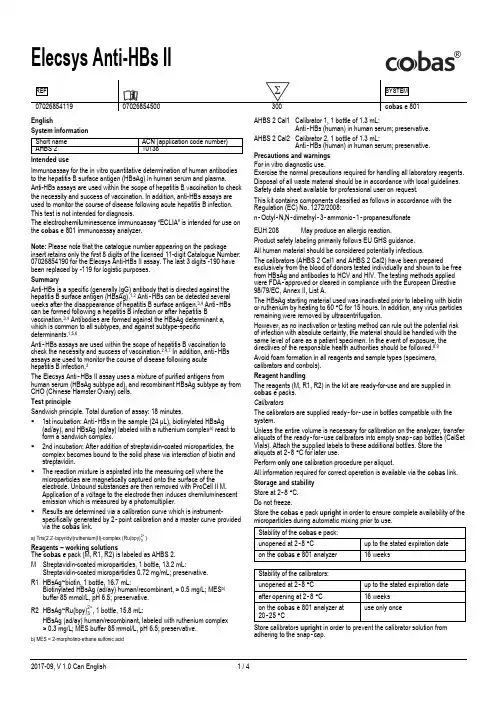
Elecsys Anti-HBs IIREFSYSTEM********************** 300cobas e 801EnglishSystem information Short name ACN (application code number) AHBS 2 10138 Immunoassay for the in vitro quantitative determination of human antibodies to the hepatitis B surface antigen (HBsAg) in human serum and plasma.Anti-HBs assays are used within the scope of hepatitis B vaccination to check the necessity and success of vaccination. In addition, anti-HBs assays are used to monitor the course of disease following acute hepatitis B infection. This test is not intended for diagnosis.The e lectro c hemi l uminescence i mmuno a ssay “ECLIA” is intended for use on the cobas e 801 immunoassay analyzer.Note: Please note that the catalogue number appearing on the package insert retains only the first 8 digits of the licensed 11-digit Catalogue Number: 07026854190 for the Elecsys Anti-HBs II assay. The last 3 digits -190 have been replaced by -119 for logistic purposes. SummaryAnti-HBs is a specific (generally IgG) antibody that is directed against the hepatitis B surface antigen (HBsAg).1,2 Anti ‑HBs can be detected several weeks after the disappearance of hepatitis B surface antigen.3,4 Anti ‑HBs can be formed following a hepatitis B infection or after hepatitis Bvaccination.3,4 Antibodies are formed against the HBsAg determinant a, which is common to all subtypes, and against subtype-specific determinants.1,5,6Anti ‑HBs assays are used within the scope of hepatitis B vaccination to check the necessity and success of vaccination.2,4,7 In addition, anti ‑HBs assays are used to monitor the course of disease following acute hepatitis B infection.3The Elecsys Anti ‑HBs II assay uses a mixture of purified antigens fromhuman serum (HBsAg subtype ad), and recombinant HBsAg subtype ay from CHO (Chinese Hamster Ovary) cells. Test principleSandwich principle. Total duration of assay: 18 minutes.▪ 1st incubation: Anti ‑HBs in the sample (24 μL), biotinylated HBsAg(ad/ay), and HBsAg (ad/ay) labeled with a ruthenium complex a) react to form a sandwich complex.▪ 2nd incubation: After addition of streptavidin-coated microparticles, thecomplex becomes bound to the solid phase via interaction of biotin and streptavidin.▪ The reaction mixture is aspirated into the measuring cell where themicroparticles are magnetically captured onto the surface of the electrode. Unbound substances are then removed with ProCell II M. Application of a voltage to the electrode then induces chemiluminescent emission which is measured by a photomultiplier.▪ Results are determined via a calibration curve which is instrument-specifically generated by 2‑point calibration and a master curve provided via the cobas link.a) Tris(2,2'-bipyridyl)ruthenium(II)-complex (Ru(bpy)32+)Reagents – working solutionsThe cobas e pack (M, R1, R2) is labeled as AHBS 2. M Streptavidin-coated microparticles, 1 bottle, 13.2 mL:Streptavidin-coated microparticles 0.72 mg/mL; preservative. R1 HBsAg~biotin, 1 bottle, 16.7 mL:Biotinylated HBsAg (ad/ay) human/recombinant, > 0.5 mg/L; MES b) buffer 85 mmol/L, pH 6.5; preservative. R2 HBsAg~Ru(bpy)32+, 1 bottle, 15.8 mL:HBsAg (ad/ay) human/recombinant, labeled with ruthenium complex > 0.3 mg/L; MES buffer 85 mmol/L, pH 6.5; preservative.b) MES = 2-morpholino-ethane sulfonic acidAHBS 2 Cal1 Calibrator 1, 1 bottle of 1.3 mL:Anti ‑HBs (human) in human serum; preservative.AHBS 2 Cal2 Calibrator 2, 1 bottle of 1.3 mL:Anti ‑HBs (human) in human serum; preservative.Precautions and warnings For in vitro diagnostic use.Exercise the normal precautions required for handling all laboratory reagents. Disposal of all waste material should be in accordance with local guidelines. Safety data sheet available for professional user on request.This kit contains components classified as follows in accordance with the Regulation (EC) No. 1272/2008:n ‑Octyl ‑N,N ‑dimethyl ‑3‑ammonio ‑1‑propanesulfonateEUH 208 May produce an allergic reaction.Product safety labeling primarily follows EU GHS guidance. All human material should be considered potentially infectious.The calibrators (AHBS 2 Cal1 and AHBS 2 Cal2) have been preparedexclusively from the blood of donors tested individually and shown to be free from HBsAg and antibodies to HCV and HIV. The testing methods applied were FDA ‑approved or cleared in compliance with the European Directive 98/79/EC, Annex II, List A.The HBsAg starting material used was inactivated prior to labeling with biotin or ruthenium by heating to 60 °C for 15 hours. In addition, any virus particles remaining were removed by ultracentrifugation.However, as no inactivation or testing method can rule out the potential risk of infection with absolute certainty, the material should be handled with the same level of care as a patient specimen. In the event of exposure, the directives of the responsible health authorities should be followed.8,9 Avoid foam formation in all reagents and sample types (specimens, calibrators and controls). Reagent handlingThe reagents (M, R1, R2) in the kit are ready-for-use and are supplied in cobas e packs. CalibratorsThe calibrators are supplied ready ‑for ‑use in bottles compatible with the system.Unless the entire volume is necessary for calibration on the analyzer, transfer aliquots of the ready ‑for ‑use calibrators into empty snap ‑cap bottles (CalSet Vials). Attach the supplied labels to these additional bottles. Store the aliquots at 2‑8 °C for later use.Perform only one calibration procedure per aliquot.All information required for correct operation is available via the cobas link. Storage and stability Store at 2‑8 °C. Do not freeze.Store the cobas e pack upright in order to ensure complete availability of the microparticles during automatic mixing prior to use. Stability of the cobas e pack: unopened at 2‑8 °Cup to the stated expiration date on the cobas e 801 analyzer 16 weeksStability of the calibrators: unopened at 2‑8 °C up to the stated expiration date after opening at 2‑8 °C 16 weeks on the cobas e 801 analyzer at 20‑25 °Cuse only onceadhering to the snap ‑cap.Specimen collection and preparationOnly the specimens listed below were tested and found acceptable.Serum collected using standard sampling tubes or tubes containing separating gel.K2‑EDTA and K3‑EDTA plasma.Criterion: Slope 1.00 ± 0.15 + intercept 0 ± 2 IU/L + bias at 10 IU/L: ≤ 30 %. Stable for 3 days at 20‑25 °C, 6 days at 2‑8 °C, 3 months at ‑20 °C(± 5 °C). The samples may be frozen 5 times.For plasma treated with lithium heparin, lithium heparin with gel or sodium heparin, the values found were on average up to 20 % lower than those obtained in serum. For plasma treated with sodium citrate, the values found were on average up to 30 % lower than those obtained with serum.The sample types listed were tested with a selection of sample collection tubes or systems that were commercially available at the time of testing, i.e. not all available tubes of all manufacturers were tested. Sample collection systems from various manufacturers may contain differing materials which could affect the test results in some cases. When processing samples in primary tubes (sample collection systems), follow the instructions of the tube manufacturer.Centrifuge samples containing precipitates and thawed samples before performing the assay.Do not use heat‑inactivated samples.Do not use samples and controls stabilized with azide.Ensure the samples and calibrators are at 20‑25 °C prior to measurement. Due to possible evaporation effects, samples and calibrators on the analyzers should be analyzed/measured within 2 hours.The performance of the Elecsys Anti‑HBs II assay has not been established with cadaveric samples or body fluids other than serum and plasma. Materials providedSee “Reagents –working solutions” section for reagents.▪ 2 x 6 bottle labelsMaterials required (but not provided)▪REF 11876317122, PreciControl Anti‑HBs, 16 x 1.3 mL▪REF 11776576322, CalSet Vials, 2 x 56 empty snap-cap bottles▪REF***********,DiluentUniversal,45.2mLsamplediluent▪▪cobas e 801 analyzerAccessories for the cobas e 801 analyzer:▪REF***********,ProCellIIM,2x2Lsystemsolution▪REF 04880293190, CleanCell M, 2 x 2 L measuring cell cleaning solution ▪REF***********,ReservoirCups,8cupstosupplyProCellIIMand CleanCell M▪REF***********,PreCleanIIM,2x2Lwashsolution▪REF***********,AssayTip/AssayCuptray,6magazinesx6magazine stacks x 105 assay tips and 105 assay cups, 3 wasteliners▪REF***********,LiquidFlowCleaningCup,2adaptorcupstosupply ISE Cleaning Solution/Elecsys SysClean for Liquid Flow CleaningDetection Unit▪REF***********,PreWashLiquidFlowCleaningCup,1adaptorcupto supply ISE Cleaning Solution/Elecsys SysClean for Liquid Flow Cleaning PreWash Unit▪REF 11298500316, ISE Cleaning Solution/Elecsys SysClean,5 x 100 mL system cleaning solutionAssayFor optimum performance of the assay follow the directions given in this document for the analyzer concerned. Refer to the appropriate operator’s manual for analyzer‑specific assay instructions.Resuspension of the microparticles takes place automatically prior to use. Place the cooled (stored at 2‑8 °C) cobas e pack on the reagent manager. Avoid foam formation. The system automatically regulates the temperature of the reagents and the opening/closing of the cobas e pack. Calibrators:Place the calibrators in the sample zone.Read in all the information necessary for calibrating the assay.CalibrationTraceability: This method has been standardized against the 1st WHO Reference Standard 1977.The predefined master curve is adapted to the analyzer using AHBS 2 Cal1 and AHBS 2 Cal2.Calibration frequency: Calibration must be performed once per reagent lot using AHBS 2 Cal1, AHBS 2 Cal2 and fresh reagent (i.e. not more than24 hours since the reagent kit was registered on the analyzer).Renewed calibration is recommended as follows:▪after 12 weeks when using the same reagent lot▪after 28 days when using the same cobas e pack on the analyzer▪as required: e.g. quality control findings with PreciControl Anti‑HBs outside the defined limitsQuality controlFor quality control, use PreciControl Anti‑HBs.Controls for the various concentration ranges should be run individually at least once every 24 hours when the test is in use, once per cobas e pack, and following each calibration.The control intervals and limits should be adapted to each laboratory’s individual requirements. Values obtained should fall within the defined limits. Each laboratory should establish corrective measures to be taken if values fall outside the defined limits.If necessary, repeat the measurement of the samples concerned.Follow the applicable government regulations and local guidelines for quality control.CalculationThe analyzer automatically calculates the analyte concentration of each sample in IU/L.Interpretation of the resultsNumeric result Result message Interpretation< 10 IU/L Non-reactive Negative for anti-HBs≥ 10 IU/L Reactive Positive for anti-HBsvary depending on the testing procedure used. Results obtained from a single sample using tests from different manufacturers can therefore differ by up to a factor of 4 (or even a factor of 10 in rare cases). If there is a change in the assay procedure used during the monitoring of vaccination protection, then the anti‑HBs values obtained upon changing over to the new method must be confirmed by parallel measurements by both methods. Vaccination strategies in certain risk groups are based on the measured anti‑HBs concentration. Respective recommendations are given by national or regional guidelines. Limitations - interferenceThe effect of the following endogenous substances and pharmaceutical compounds on assay performance was tested. Interferences were tested up to the listed concentrations and no impact on results was observed. Endogenous substancesCompound Concentration testedBilirubin ≤ 513 μmol/L or ≤ 30 mg/dL Hemoglobin ≤ 0.621 mmol/L or ≤ 1000 mg/dL Intralipid ≤ 1500 mg/dLBiotin ≤ 41 nmol/L or ≤ 10 ng/mL Rheumatoid factors ≤ 1200 IU/mLAlbumin ≤ 7.0 g/dLIgG ≤ 7.0 g/dLIgA ≤ 1.6 g/dLIgM ≤ 1.0 g/dL2 / 42017-09, V 1.0 Can EnglishCriterion: Recovery for samples from Limit of Detection to 10 IU/L:≤ ± 2 IU/L, and samples > 10 IU/L: ≤ ± 20 % of initial value.Samples should not be taken from patients receiving therapy with high biotin doses (i.e. > 5 mg/day) until at least 8 hours following the last biotin administration.Pharmaceutical substancesIn vitro tests were performed on 16 commonly used pharmaceuticals. No interference with the assay was found.In addition, the following special drugs used in hepatitis B therapy were tested. No interference with the assay was found.Special drugsDrug Concentration testedmg/LPeginterferon alfa‑2a ≤ 0.18Peginterferon alfa‑2b ≤ 1.6Lamivudine ≤ 300Adefovir ≤ 10Entecavir ≤ 10Tenofovir ≤ 600Telbivudine ≤ 245Due to high-dose hook effect c), results from anti‑HBs concentrations of> 200000 IU/L may be found below the upper limit of the measuring range of 1000 IU/L. In rare cases, a high-dose hook effect from anti HBs concentrations of < 20000 IU/L cannot be excluded. Therefore in case of any unexpected low result the sample should be diluted 1:100 (refer to chapter “Dilution”) and tested again.In rare cases, interference due to extremely high titers of antibodies to streptavidin and ruthenium can occur. The test contains additives which minimize these effects.c) High-dose hook effect: A sample with a true concentration clearly above the measuring range, but found within the measuring range.Limits and rangesMeasuring range2‑1000 IU/L (defined by the Limit of Detection and the maximum of the master curve). Values below the Limit of Detection are reported as< 2 IU/L.Values above the measuring range are reported as > 1000 IU/L (or up to 100000 IU/L for 100‑fold diluted samples).DilutionSamples with anti‑HBs concentrations above the measuring range can be diluted with Diluent Universal. The recommended dilution is 1:100 (either automatically by the analyzer or manually). The concentration of the diluted sample must be > 10 IU/L.After manual dilution, multiply the result by the dilution factor.After dilution by the analyzer, the software automatically takes the dilution into account when calculating the sample concentration.Manual dilution can also be made with negative human serum.Note: Antibodies to HBsAg are heterogeneous. In some isolated cases, this may lead to non-linear dilution behavior.Specific performance dataRepresentative performance data on the analyzer is given below. Results obtained in individual laboratories may differ.PrecisionPrecision was determined using Elecsys reagents, samples and controls in a protocol (EP05‑A3) of the CLSI (Clinical and Laboratory Standards Institute): 2 runs per day in duplicate each for 21 days (n = 84). The following results were obtained:cobas e 801 analyzerRepeatability d)Intermediateprecision e)Sample MeanIU/LSDIU/LCV%SDIU/LCV% Human serum 1 4.33 0.224 5.2 0.272 6.3 Human serum 2 12.0 0.237 2.0 0.277 2.3 Human serum 3 475 6.81 1.4 7.55 1.6 PC f) Anti-HBs 1 < 2.00 - - - -PC Anti-HBs 2 83.8 1.08 1.3 1.28 1.5d) Repeatability = within-run precisione) Intermediate precision = between-run precisionf) PC = PreciControlAnalytical specificityNo cross-reactions with HAV, HCV, HEV, CMV, EBV, HIV, Rubella, Toxoplasma gondii, Treponema pallidum, rheumatoid arthritis, autoimmune response or alcoholic liver disease were observed.Measurements were performed on each of the pathogens listed above using ≥ 8 serum or plasma samples which were positive for antibodies to the above-mentioned pathogens.Relative sensitivityPerformance of the Elecsys Anti‑HBs II assay has been assessed by testing a total of 669 samples at two different study sites. 296 samples from vaccinated persons and 373 samples from patients recovered from a hepatitis B infection have been measured with the Elecsys Anti‑HBs II assay and another commercially available fully automated anti‑HBs assay. Discrepant samples were tested with additional anti‑HBs assays to achieve a consensus.Characterization ofsamplesN ElecsysAnti‑HBs IIreactiveAnti‑HBscomparisontest reactiveSensitivity%Anti-HBs positive:vaccinees 296 296 296 100Anti-HBs positive:recovered from ahepatitis B infection373 373 373 100 Total 669 669 669 100 Relative specificityPerformance of the Elecsys Anti‑HBs II assay has been assessed by testing 2673 samples from blood donors negative for anti‑HBs at two different study sites and 1623 anti‑HBs negative samples from laboratory routine at three different study sites. Discrepant samples were tested with additional anti‑HBs assays to achieve a consensus.Characterization of samples N ElecsysAnti‑HBs IIfalsepositiveSpecificity%Anti-HBs negative: blood donors 2673 6 99.78 Anti-HBs negative: routinesamples1623 9 99.45 References1Seeger C, Zoulim F, Mason WS. Hepadnaviruses. In: Field’s Virology, Knipe DM, Howley RM (eds), 2007 5th edition, Lippincott Williams andWilkins, Philadelphia, USA. Chapter 76, pp2977-3029.2WHO. Hepatitis B vaccines. Wkly Epidemiol Rec 2009;84:405-420.3Liaw YF, Chu CM. Hepatitis B virus infection. Lancet2009;373:582-592.4Caspari G, Gerlich WH. The serologic markers of hepatitis B virus infection – proper selection and standardized interpretation. Clin Lab2007;53:335-343.5Kramvis A, Kew M, François G. Hepatitis B virus genotypes. Vaccine 2005;23:2409-2423.6Michel ML, Tiollais P. Hepatitis B vaccines: protective efficacy and therapeutic potential. Pathol Biol 2010;58:288-295.7Elgouhari HM, Abu-Rajab Tamimi TI, Carey WD. Hepatitis B virus infection: understanding its epidemiology, course, and diagnosis. Cleve Clin J Med 2008;75:881-889.8Occupational Safety and Health Standards: Bloodborne pathogens. (29 CFR Part 1910.1030). Fed. Register.9Directive 2000/54/EC of the European Parliament and Council of18 September 2000 on the protection of workers from risks related toexposure to biological agents at workFor further information, please refer to the appropriate operator’s manual for the analyzer concerned, the respective application sheets, the product information and the Method Sheets of all necessary components (if available in your country).A point (period/stop) is always used in this Method Sheet as the decimal separator to mark the border between the integral and the fractional parts of a decimal numeral. Separators for thousands are not used.SymbolsRoche Diagnostics uses the following symbols and signs in addition to those listed in the ISO 15223‑1 standard:CONTENT Contents of kitSYSTEM Analyzers/Instruments on which reagents can be used REAGENT ReagentCALIBRATOR CalibratorVolume after reconstitution or mixingGTIN Global Trade Item NumberCOBAS, COBAS E, ELECSYS and PRECICONTROL are trademarks of Roche. INTRALIPID is a trademark of Fresenius Kabi AB.All other product names and trademarks are the property of their respective owners. Additions, deletions or changes are indicated by a change bar in the margin.© 2016, Roche DiagnosticsRoche Diagnostics GmbH, Sandhofer Strasse 116, D-68305 Mannheim。
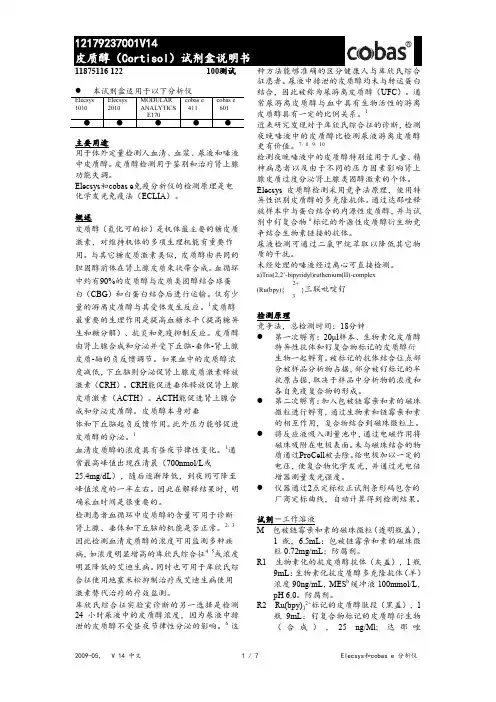
11875116 122 100测试主要用途用于体外定量检测人血清、血浆、尿液和唾液中皮质醇。
皮质醇检测用于鉴别和治疗肾上腺功能失调。
Elecsys和cobas e免疫分析仪的检测原理是电化学发光免疫法(ECLIA)。
概述皮质醇(氢化可的松)是机体最主要的糖皮质激素,对维持机体的多项生理机能有重要作用。
与其它糖皮质激素类似,皮质醇由共同的胆固醇前体在肾上腺皮质束状带合成。
血循环中约有90%的皮质醇与皮质类固醇结合球蛋白(CBG)和白蛋白结合后进行运输。
仅有少量的游离皮质醇与其受体发生反应。
1皮质醇最重要的生理作用是提高血糖水平(提高糖异生和糖分解)、抗炎和免疫抑制反应。
皮质醇由肾上腺合成和分泌并受下丘脑-垂体-肾上腺皮质-轴的负反馈调节。
如果血中的皮质醇浓度减低,下丘脑则分泌促肾上腺皮质激素释放激素(CRH)。
CRH能促进垂体释放促肾上腺皮质激素(ACTH)。
ACTH能促进肾上腺合成和分泌皮质醇。
皮质醇本身对垂体和下丘脑起负反馈作用。
此外压力能够促进皮质醇的分泌。
1血清皮质醇的浓度具有昼夜节律性变化。
1通常最高峰值出现在清晨(700nmol/L或25.4mg/dL),随后逐渐降低,到夜间可降至峰值浓度的一半左右。
因此在解释结果时,明确采血时间是很重要的。
检测患者血循环中皮质醇的含量可用于诊断肾上腺、垂体和下丘脑的机能是否正常。
2,3因此检测血清皮质醇的浓度可用监测多种疾病,如浓度明显增高的库欣氏综合征4,5或浓度明显降低的艾迪生病。
同时也可用于库欣氏综合征使用地塞米松抑制治疗或艾迪生病使用激素替代治疗的疗效监测。
库欣氏综合征实验室诊断的另一选择是检测24小时尿液中的皮质醇浓度,因为尿液中排泄的皮质醇不受昼夜节律性分泌的影响。
6这种方法能够准确的区分健康人与库欣氏综合征患者。
尿液中排泄的皮质醇均未与转运蛋白结合,因此被称为尿游离皮质醇(UFC)。
通常尿游离皮质醇与血中具有生物活性的游离皮质醇具有一定的比例关系。
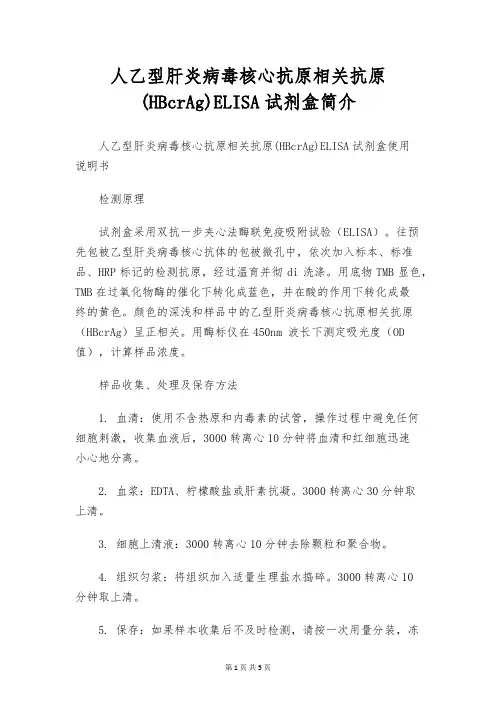
人乙型肝炎病毒核心抗原相关抗原(HBcrAg)ELISA试剂盒简介人乙型肝炎病毒核心抗原相关抗原(HBcrAg)ELISA试剂盒使用说明书检测原理试剂盒采用双抗一步夹心法酶联免疫吸附试验(ELISA)。
往预先包被乙型肝炎病毒核心抗体的包被微孔中,依次加入标本、标准品、HRP标记的检测抗原,经过温育并彻di洗涤。
用底物TMB显色,TMB在过氧化物酶的催化下转化成蓝色,并在酸的作用下转化成最终的黄色。
颜色的深浅和样品中的乙型肝炎病毒核心抗原相关抗原(HBcrAg)呈正相关。
用酶标仪在450nm 波长下测定吸光度(OD 值),计算样品浓度。
样品收集、处理及保存方法1. 血清:使用不含热原和内毒素的试管,操作过程中避免任何细胞刺激,收集血液后,3000转离心10分钟将血清和红细胞迅速小心地分离。
2. 血浆:EDTA、柠檬酸盐或肝素抗凝。
3000转离心30分钟取上清。
3. 细胞上清液:3000转离心10分钟去除颗粒和聚合物。
4. 组织匀浆:将组织加入适量生理盐水捣碎。
3000转离心10分钟取上清。
5. 保存:如果样本收集后不及时检测,请按一次用量分装,冻存于20℃,避免反复冻融,在室温下解冻并确保样品均匀地充分解冻。
自备物品1. 酶标仪(450nm)2. 高精度加样器及枪头:0.510uL、220uL、20200uL、2001000uL3. 37℃恒温箱操作注意事项试剂盒保存在28℃,使用前室温平衡20分钟。
从冰箱取出的浓缩洗涤液会有结晶,这属于正常现象,水浴加热使结晶wan全溶解后再使用。
实验中不用的板条应立即放回自封袋中,密封(低温干燥)保存。
浓度为0的S0号标准品即可视为阴性对照或者空白;按照说明书操作时样本已经稀释5倍,最终结果乘以5才是样本实际浓度。
严格按照说明书中标明的时间、加液量及顺序进行温育操作。
所有液体组分使用前充分摇匀。
试剂盒组成名称 96孔配置 48孔配置备注微孔酶标板 12孔×8条 12孔×4条无标准品 0.3mL*6管 0.3mL*6管无样本稀释液 6mL 3mL 无检测抗原HRP 10mL 5mL 无20×洗涤缓冲液 25mL 15mL 按说明书进行稀释底物A 6mL 3mL 无底物B 6mL 3mL 无终止液 6mL 3mL 无封板膜 2张 2张无说明书 1份 1份无自封袋 1个 1个无注:标准品(S0S5)浓度依次为:0、12.5、25、50、100、200 pg/ml试剂的准备20×洗涤缓冲液的稀释:蒸馏水按1:20稀释,即1份的20×洗涤缓冲液加19份的蒸馏水。
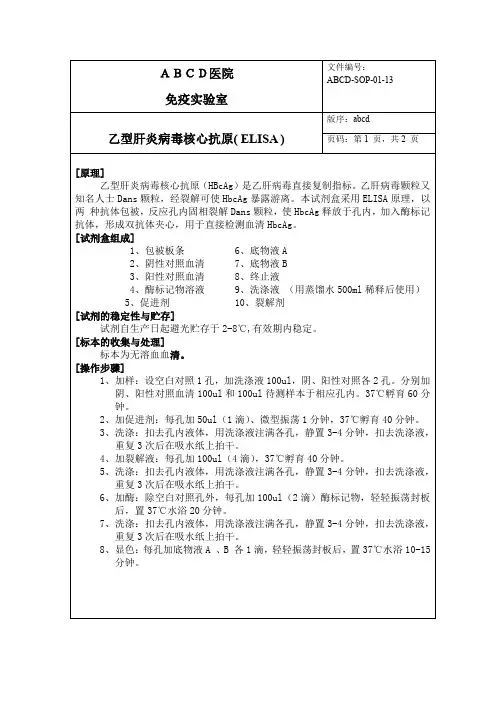
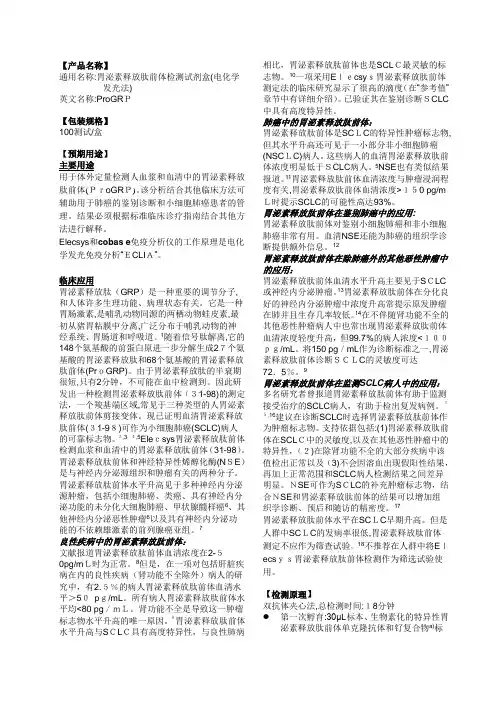
【产品名称】通用名称:胃泌素释放肽前体检测试剂盒(电化学发光法)英文名称:ProGRP【包装规格】100测试/盒【预期用途】主要用途用于体外定量检测人血浆和血清中的胃泌素释放肽前体(ProGRP)。
该分析结合其他临床方法可辅助用于肺癌的鉴别诊断和小细胞肺癌患者的管理。
结果必须根据标准临床诊疗指南结合其他方法进行解释。
Elecsys和cobas e免疫分析仪的工作原理是电化学发光免疫分析“ECLIA”。
临床应用胃泌素释放肽(GRP)是一种重要的调节分子,和人体许多生理功能、病理状态有关。
它是一种胃肠激素,是哺乳动物同源的两栖动物蛙皮素,最初从猪胃粘膜中分离,广泛分布于哺乳动物的神经系统、胃肠道和呼吸道。
1随着信号肽解离,它的148个氨基酸的前蛋白原进一步分解生成27个氨基酸的胃泌素释放肽和68个氨基酸的胃泌素释放肽前体(ProGRP)。
由于胃泌素释放肽的半衰期很短,只有2分钟,不可能在血中检测到。
因此研发出一种检测胃泌素释放肽前体(31-98)的测定法,一个羧基端区域,常见于三种类型的人胃泌素释放肽前体剪接变体。
现已证明血清胃泌素释放肽前体(31-98)可作为小细胞肺癌(SCLC)病人的可靠标志物。
2,3,4,5Elecsys胃泌素释放肽前体检测血浆和血清中的胃泌素释放肽前体(31-98)。
胃泌素释放肽前体和神经特异性烯醇化酶(NSE)是与神经内分泌源组织和肿瘤有关的两种分子。
胃泌素释放肽前体水平升高见于多种神经内分泌源肿瘤,包括小细胞肺癌、类癌、具有神经内分泌功能的未分化大细胞肺癌、甲状腺髓样癌6、其他神经内分泌恶性肿瘤6以及具有神经内分泌功能的不依赖雄激素的前列腺癌亚组。
7良性疾病中的胃泌素释放肽前体:文献报道胃泌素释放肽前体血清浓度在2-50pg/mL时为正常。
8但是,在一项对包括肝脏疾病在内的良性疾病(肾功能不全除外)病人的研究中,有2.5%的病人胃泌素释放肽前体血清水平>50pg/mL。
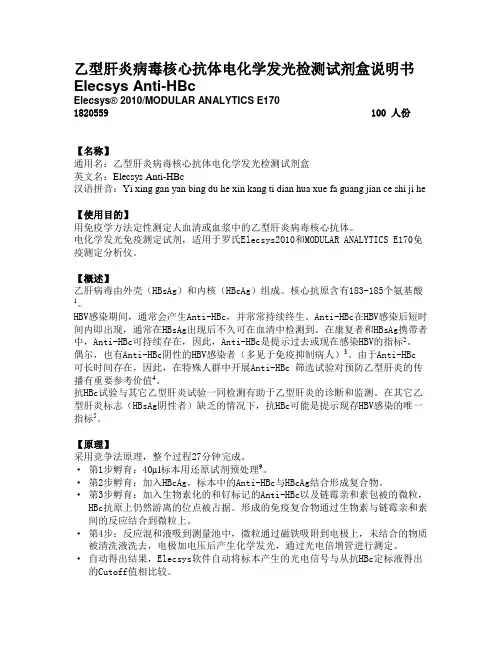
乙型肝炎病毒核心抗体电化学发光检测试剂盒说明书Elecsys Anti-HBcElecsys® 2010/MODULAR ANALYTICS E1701820559 100 人份【名称】通用名:乙型肝炎病毒核心抗体电化学发光检测试剂盒英文名:Elecsys Anti-HBc汉语拼音:Yi xing gan yan bing du he xin kang ti dian hua xue fa guang jian ce shi ji he【使用目的】用免疫学方法定性测定人血清或血浆中的乙型肝炎病毒核心抗体。
电化学发光免疫测定试剂,适用于罗氏Elecsys2010和MODULAR ANALYTICS E170免疫测定分析仪。
【概述】乙肝病毒由外壳(HBsAg)和内核(HBcAg)组成。
核心抗原含有183-185个氨基酸1。
HBV感染期间,通常会产生Anti-HBc,并常常持续终生。
Anti-HBc在HBV感染后短时间内即出现,通常在HBsAg出现后不久可在血清中检测到。
在康复者和HBsAg携带者中,Anti-HBc可持续存在,因此,Anti-HBc是提示过去或现在感染HBV的指标2。
偶尔,也有Anti-HBc阴性的HBV感染者(多见于免疫抑制病人)3。
由于Anti-HBc 可长时间存在,因此,在特殊人群中开展Anti-HBc 筛选试验对预防乙型肝炎的传播有重要参考价值4。
抗HBc试验与其它乙型肝炎试验一同检测有助于乙型肝炎的诊断和监测。
在其它乙型肝炎标志(HBsAg阴性者)缺乏的情况下,抗HBc可能是提示现存HBV感染的唯一指标5。
【原理】采用竞争法原理,整个过程27分钟完成。
·第1步孵育:40µl标本用还原试剂预处理9。
·第2步孵育:加入HBcAg,标本中的Anti-HBc与HBcAg结合形成复合物。
·第3步孵育:加入生物素化的和钌标记的Anti-HBc以及链霉亲和素包被的微粒, HBc抗原上仍然游离的位点被占据。
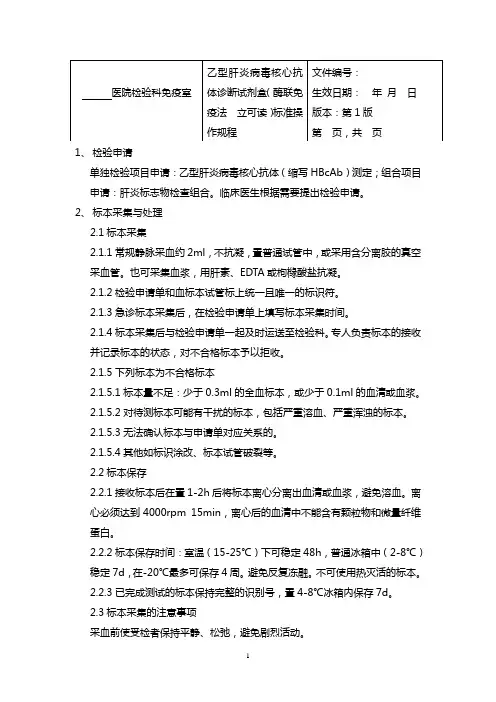
1、检验申请单独检验项目申请:乙型肝炎病毒核心抗体(缩写HBcAb)测定;组合项目申请:肝炎标志物检查组合。
临床医生根据需要提出检验申请。
2、标本采集与处理2.1标本采集2.1.1常规静脉采血约2ml,不抗凝,置普通试管中,或采用含分离胶的真空采血管。
也可采集血浆,用肝素、EDTA或枸橼酸盐抗凝。
2.1.2检验申请单和血标本试管标上统一且唯一的标识符。
2.1.3急诊标本采集后,在检验申请单上填写标本采集时间。
2.1.4标本采集后与检验申请单一起及时运送至检验科。
专人负责标本的接收并记录标本的状态,对不合格标本予以拒收。
2.1.5下列标本为不合格标本2.1.5.1标本量不足:少于0.3ml的全血标本,或少于0.1ml的血清或血浆。
2.1.5.2对待测标本可能有干扰的标本,包括严重溶血、严重浑浊的标本。
2.1.5.3无法确认标本与申请单对应关系的。
2.1.5.4其他如标识涂改、标本试管破裂等。
2.2标本保存2.2.1接收标本后在置1-2h后将标本离心分离出血清或血浆,避免溶血。
离心必须达到4000rpm 15min,离心后的血清中不能含有颗粒物和微量纤维蛋白。
2.2.2标本保存时间:室温(15-25℃)下可稳定48h,普通冰箱中(2-8℃)稳定7d,在-20℃最多可保存4周。
避免反复冻融。
不可使用热灭活的标本。
2.2.3已完成测试的标本保持完整的识别号,置4-8℃冰箱内保存7d。
2.3标本采集的注意事项采血前使受检者保持平静、松弛,避免剧烈活动。
3.方法原理本实验采用基因工程重组HBcAg包被反应板,加入待测标本,同时加入抗-HBc-HRP,与抗原形成竞争结合,如待测标本中抗-HBc含量高,则抗-HBc-HRP 与HBcAg结合少,加入TMB底物时显色淡,反之则显色深。
4.试剂及其他用品4.1试剂:乙型肝炎病毒核心抗体诊断试剂盒,由上海科华生物技术有限公司出品,试剂盒药品批准文号:国药准字S1*******(48人份);国药准字S1*******(96人份)。
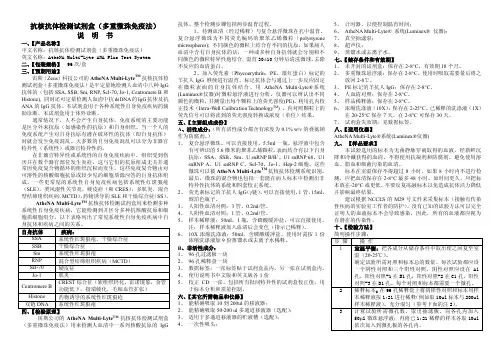
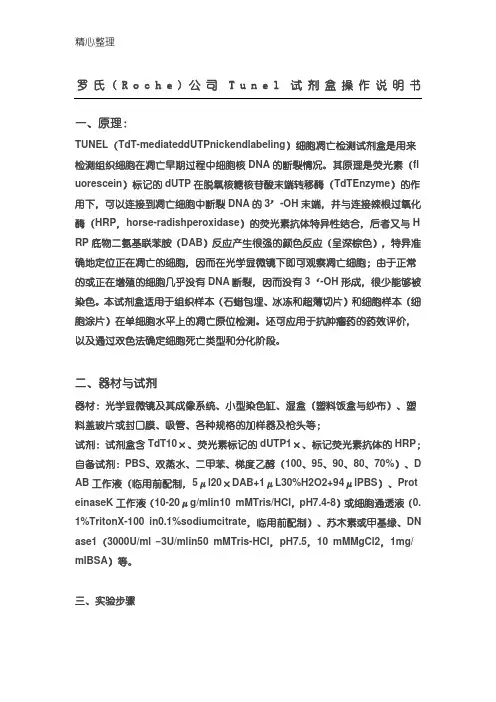
罗氏(R o c h e)公司T u n e l试剂盒操作说明书一、原理:TUNEL(TdT-mediateddUTPnickendlabeling)细胞凋亡检测试剂盒是用来检测组织细胞在凋亡早期过程中细胞核DNA的断裂情况。
其原理是荧光素(fl uorescein)标记的dUTP在脱氧核糖核苷酸末端转移酶(TdTEnzyme)的作1%TritonX-100 in0.1%sodiumcitrate,临用前配制)、苏木素或甲基绿、DN ase1(3000U/ml–3U/mlin50 mMTris-HCl,pH7.5,10 mMMgCl2,1mg/ mlBSA)等。
三、实验步骤操作流程图:制作石蜡切片→脱蜡、水合→细胞通透→加TUNEL反应液→加c onverter-POD→与底物DAB反应显色→光学显微镜计数并拍照。
具体操作步骤(石蜡包埋切片的检测):1.用二甲苯浸洗2次,每次5min;2.用梯度乙醇(100、95、90、80、70%)各浸洗1次,每次3min;注:上面两步是针对石蜡切片样本的处理4.用ProteinaseK工作液处理组织15-30min在21–37°C(温度、时间、浓二甲苯透明、中性树胶封片。
15.加一滴PBS或甘油在视野下,用光学显微镜观察凋亡细胞(共计200~500个细胞)并拍照。
可结合凋亡细胞形态特征来综合判断(未染色细胞变小,胞膜完整但出现发泡现象,晚期出现凋亡小体,贴壁细胞出现邹缩、变圆、脱落;而染色细胞呈现染色质浓缩、边缘化,核膜裂解,染色质分割成块状/凋亡小体)对于培养细胞的预处理:①在载玻片上铺一层薄薄的多聚赖氨酸(见备注4),干燥后在去离子水中漂洗,干燥后4℃保存;②适当方法诱导细胞凋亡,同时设未经诱导的对照组,各组离心收集约1×106个细胞,PBS洗一次,重悬,加到铺好的多聚赖氨酸载玻片上,自然干燥,使细胞很好的吸附到载玻片上;③将吸附细胞的载玻片在4%多聚甲醛(见备注2)中固定25min;④PBS浸洗二次,每次5min;水(二甲苯)透明、封片后通过光学显微镜观察操作。
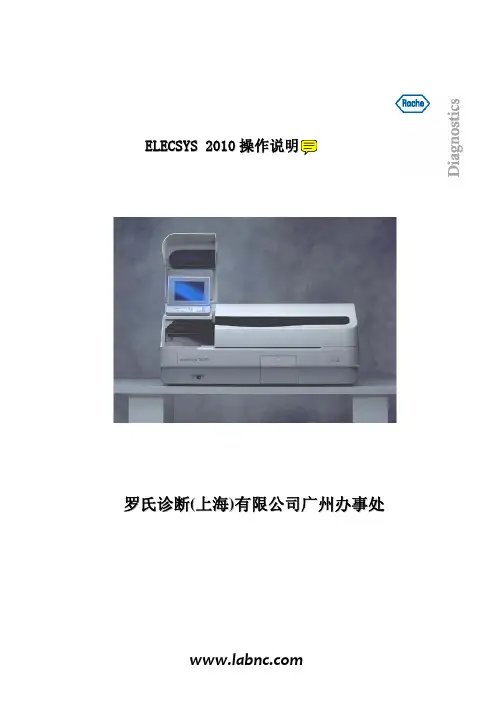
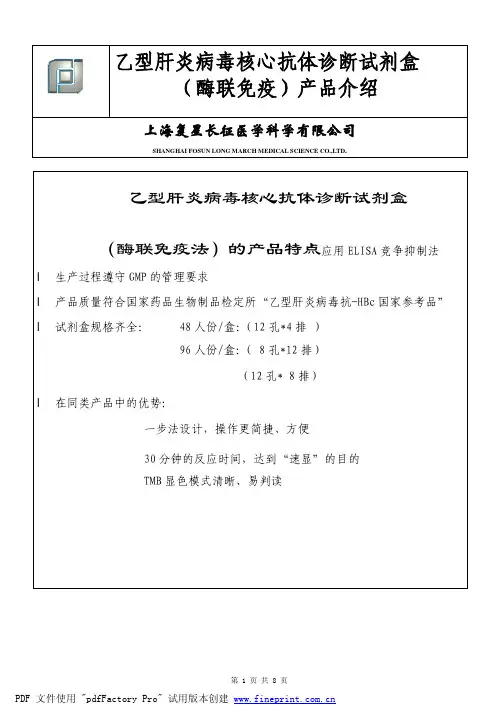
(酶联免疫)产品介绍上海复星长征医学科学有限公司SHANGHAI FOSUN LONG MARCH MEDICAL SCIENCE CO.,LTD.乙型肝炎病毒核心抗体诊断试剂盒(酶联免疫法)的产品特点应用ELISA竞争抑制法l生产过程遵守GMP的管理要求l产品质量符合国家药品生物制品检定所“乙型肝炎病毒抗-HBc国家参考品”l试剂盒规格齐全: 48人份/盒:(12孔*4排)96人份/盒:( 8孔*12排)(12孔* 8排)l在同类产品中的优势:一步法设计,操作更简捷、方便30分钟的反应时间,达到“速显”的目的TMB显色模式清晰、易判读(酶联免疫)产品介绍上海复星长征医学科学有限公司SHANGHAI FOSUN LONG MARCH MEDICAL SCIENCE CO.,LTD.乙型肝炎病毒核心抗体诊断试剂盒使用说明书批准文号:国药准字S1*******本品系用纯化乙型肝炎病毒核心抗原作包被,再配以酶标记特异性乙型肝炎病毒核心抗体以及缓冲液和其它试剂组成,采用ELISA竞争抑制法检测人血清、血浆和其它样品中的乙型肝炎病毒核心抗体。
试剂盒组分:48人份96人份1.包被抗原微孔板48孔96孔2.酶标记工作液1瓶3.5mL 7mL3.乙型肝炎病毒核心抗体阳性对照1瓶0.3mL 1.0mL4.乙型肝炎病毒核心抗体阴性对照1瓶0.3mL 1.0mL5.封片(及时贴) 2片2片2片6.浓缩洗涤液1瓶10mL 24mL7.TMB显色剂A 1瓶 3.5mL 7mL8.TMB显色剂B 1瓶 3.5mL 7mL9.终止液1瓶 3.5mL 7mL(酶联免疫)产品介绍上海复星长征医学科学有限公司SHANGHAI FOSUN LONG MARCH MEDICAL SCIENCE CO.,LTD.操作步骤:1. 将包被条固定于支架顺序编号,必要时用胶布固定。
2. 设阳性对照(2孔),每孔加入乙型肝炎病毒核心抗体阳性对照50微升。
【产品名称】通用名称:他克莫司检测试剂盒(电化学发光法)英文名称:Tacrolimus【包装规格】100测试/盒【预期用途】主要用途主要用于定量测定人全血中他克莫司的含量。
本检测有助于接受他克莫司治疗的心、肝、肾移植病人的治疗。
电化学发光免疫测定试剂“ECLIA”,适用于罗氏Elecsys 和cobas e免疫测定分析仪。
临床应用他克莫司(又称KF506)是一种大环内酯类抗生素,1984年在日本被发现,是链霉菌属的代谢产物1.2,3。
研究表明他克莫司的免疫抑制活性是环孢霉素的10-100倍。
4他克莫司产生免疫抑制效应的主要原理在于它可以抑制T细胞的激活和增殖。
细胞内的他克莫司可结合一种抑免蛋白FK506-结合蛋白(FKBP-12),这种免疫复合物可抑制磷酸酶的活性。
5抑制磷酸酶可限制激活的T细胞(NFAT)的核因子的去磷酸化和核转位,由此调节包括IL-2、IL-4、TNF-α和γ-干扰素在内的多种细胞因子的转录,进一步限制淋巴细胞的激活和增殖。
6,7,8,9,10他克莫司具有很高的亲脂性,吸收不完全并且不稳定。
吸收后,他克莫司高效结合蛋白和红细胞,血浆中99%的药物都与白蛋白或α-1-糖蛋白结合。
11他克莫司的生物利用度和代谢主要受细胞色素P450药物代谢同工酶CYP3A4和CYP3A5以及流出泵P-糖蛋白的影响,在表达和功能方面在同一个体以及不同个体之间都变现出明显的差异。
12,13,14他克莫司在同一病人和不同病人间都表现出很大的变异性,无论剂量高低都可能出现严重不良反应。
他克莫司浓度不足可能导致对抑制器官的排异反应。
浓度过高又可导致严重不良反应。
他克莫司的主要不良反应包括肾毒性、神经毒性、胃肠道损害、糖尿病、高血压病和恶性肿瘤。
15,16为了让每个病人的体内药物浓度都维持在狭窄的治疗窗范围内,治疗药物监测的应用和浓度控制下给药作为标准临床实践的一部分已在临床上应用多年,它也是病人治疗的主要手段。
乙肝五项手工加样说明书标题:乙肝五项手工加样说明书1. 产品简介:乙肝五项手工加样试剂盒是一种用于检测乙型肝炎病毒(HBV)感染的试剂盒。
它可以同时检测乙肝表面抗原(HBsAg)、乙肝e抗原(HBeAg)、乙肝e抗体(HBeAb)、乙肝核心抗体(HBcAb IgM)和乙肝表面抗体(HBsAb)等五个指标。
2. 试剂盒组成:乙肝五项手工加样试剂盒由以下组分组成:- HBsAg抗原检测试剂- HBeAg抗原检测试剂- HBeAb抗体检测试剂- HBcAb IgM抗体检测试剂- HBsAb抗体检测试剂- 阴性对照血清- 强阳性对照血清- 微孔板(带标记)- 加样液3. 操作步骤:以下是乙肝五项手工加样试剂盒的操作步骤:步骤1:取出标记好的微孔板。
步骤2:将标记好的微孔板放置在工作台上。
步骤3:打开HBsAg抗原检测试剂瓶盖,将试剂滴入微孔板的标记孔中。
步骤4:重复步骤3,分别用HBeAg抗原检测试剂、HBeAb抗体检测试剂、HBcAb IgM抗体检测试剂和HBsAb抗体检测试剂加样到相应的标记孔中。
步骤5:将阴性对照血清加样到阴性对照孔中。
步骤6:将强阳性对照血清加样到强阳性对照孔中。
步骤7:倒入适量的加样液,并轻轻拍打微孔板使试剂充分混合。
步骤8:将微孔板移到孵育器中进行适当的温度和时间的孵育。
步骤9:取出孵育后的微孔板,进行结果的读取和解析。
4. 注意事项:- 操作前请仔细阅读说明书,并严格按照操作步骤进行操作。
- 使用过程中要注意无菌操作,避免任何异物和污染物进入试剂和微孔板中。
- 获得的结果应仅作参考,需结合临床病史和其他检查结果进行综合判断。
- 试剂盒仅供专业人员使用。
- 请注意保存试剂和对照血清的条件,并按要求做好试剂的贮存和使用记录。
以上为乙肝五项手工加样试剂盒的简要说明书,具体操作请参照产品说明书进行操作。
若有任何疑问,请咨询相关专业人员。
乙肝 e 抗原・ Elecsys通用稀释液 货号1732277・ Elecsys 系统缓冲液(ProCell)货号1662988・ Elecsys测量池清洗液(CleanCell)货号1662970・ Elecsys 添加剂液(SysWash)货号1930346・ Elecsys 系统清洗液(SysClean)货号1298500方法:按仪器操作说明进行操作。
检查试剂与消耗品是否充足。
使用前需混匀微粒。
仪器通过扫描试剂盒条形码自动输入测试所需的特异性参数,不需手工输入。
如果特殊情况下仪器无法阅读条形码,可以手工输入15位数字。
将冷藏试剂预温到20 度后放置于Elecsys2010的试剂盘上,避免产生泡沫。
系统自动控制试剂温度和开/关试剂瓶盖。
将HBeAgCal1和Cal2放在2010分析仪的标本测试区。
只在标定时打开瓶盖。
条形码自动提供定标所需的数据资料。
定标完成后,将Cal 1和Cal 2放回2-8 度保存。
定标:Elecsys HBeAg已经用德国Paul Ehrlich研究所的“HBe参照抗原82(HBeAg)”标定。
所用单位(U/ml)是Paul Ehrlich研究所单位。
每批HBeAg试剂盒必须用新鲜试剂和HBeAgCal1,Cal2定标一次。
另外,以下情况需要再次定标:・ 一个月以后(使用同一批号试剂)・ 7天以后(使用同一只试剂盒)・ 根据需要进行标定:如质控结果超出范围时。
定标范围:阴性(Cal 1) 300-2000阳性(Cal 2) 20000-100000 质控:ElecsysHBeAg质控1和2(PreciControl)。
质控1和质控2至少每24小时或每一次定标后测定一次。
质控间隔期应适用于各实验室的具体要求。
检测值应落在确定的范围内,如出现质控值落在范围以外,应采取校正措施。
计算:2010仪器会自动根据Cal1和Cal2的测定值计算Cut-off值。
每一个标本的结果以“有反应性”或“无反应性”以及Cut-off指数形式或 标本信号/Cut-off报告。